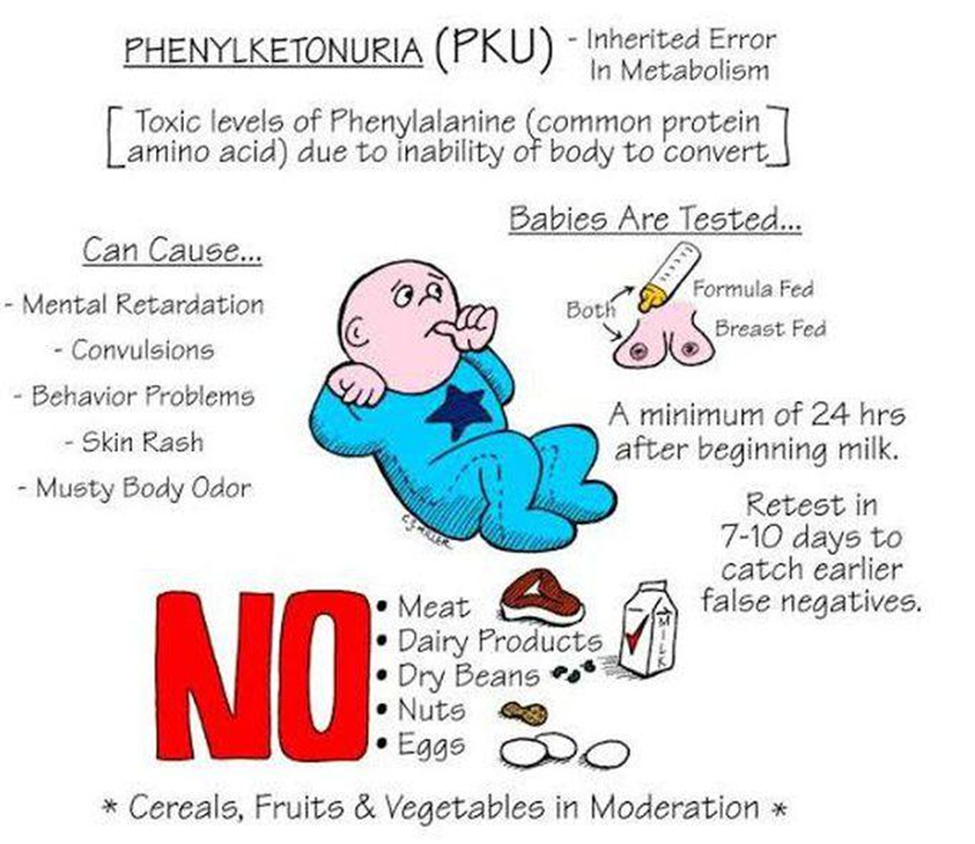A parent brings a 2-week-old infant to a clinic for a phenylketonuria rescreening blood test. The test indicates a serum phenylalanine level of 1 mg/dL (60.5 mcmol/L). The nurse reviews this result and makes which interpretation?
It is inconclusive
it is negative
it requires rescreening at age 6 weeks.
It is positive
The Correct Answer is B
A. It is inconclusive
Explanation: A serum phenylalanine level within the normal range is considered conclusive in ruling out phenylketonuria. Inconclusive results typically occur when there are issues with the sample or testing process.
B. It is negative
Explanation:
A serum phenylalanine level of 1 mg/dL (60.5 mcmol/L) in a 2-week-old infant is within the normal range. In the context of phenylketonuria (PKU) screening, a "negative" result means that the phenylalanine levels are within the expected range, and there is no evidence of phenylketonuria.
C. It requires rescreening at age 6 weeks.
Explanation: If the initial screening result is within the normal range, rescreening at age 6 weeks may not be necessary for phenylketonuria. The timing and need for rescreening may vary based on local protocols and individual patient factors.
D. It is positive
Explanation: A positive result for phenylketonuria would indicate that the serum phenylalanine levels are elevated, suggesting a potential diagnosis of PKU. In this case, the result is negative, meaning there is no evidence of PKU.

Nursing Test Bank
Naxlex Comprehensive Predictor Exams
Related Questions
Correct Answer is D
Explanation
A. "Limit your caloric intake to avoid becoming overweight."
Explanation: This statement emphasizes the importance of maintaining a healthy weight through balanced nutrition and avoiding excessive caloric intake. It promotes the prevention of overweight and obesity.
B. "Tanning beds are much safer than lying in the sun."
Explanation: This statement is incorrect. Tanning beds are not safer than natural sunlight and are associated with an increased risk of skin cancer. Adolescents should be advised to protect their skin from harmful UV radiation.
C. "Share piercing needles only with close friends you trust."
Explanation: This statement is unsafe and promotes risky behavior. Sharing piercing needles can lead to the transmission of bloodborne infections such as HIV and hepatitis. The nurse should emphasize the importance of using sterile needles and avoiding risky behaviors.
D. "Your need for sleep will increase during periods of growth."
Explanation:
During periods of growth, adolescents often experience increased physical and hormonal changes, and adequate sleep is crucial for overall health and well-being. Sleep plays a vital role in growth, immune function, and cognitive performance. Adolescents should be encouraged to prioritize getting sufficient sleep for their age group.
Correct Answer is C
Explanation
A. 9 months: By 9 months, most infants would have well exceeded doubling their birth weight.
B. 12 months: Doubling of birth weight usually occurs earlier, by around 5 to 6 months, rather than 12 months.
C. 6 months
Explanation:
The general guideline is that infants tend to double their birth weight by around 5 to 6 months of age. This doubling of birth weight is a common marker of healthy growth and development during the first few months of life.
D. 3 months: By 3 months, while infants experience significant growth, they usually haven't doubled their birth weight yet.
Whether you are a student looking to ace your exams or a practicing nurse seeking to enhance your expertise , our nursing education contents will empower you with the confidence and competence to make a difference in the lives of patients and become a respected leader in the healthcare field.
Visit Naxlex, invest in your future and unlock endless possibilities with our unparalleled nursing education contents today
Report Wrong Answer on the Current Question
Do you disagree with the answer? If yes, what is your expected answer? Explain.
Kindly be descriptive with the issue you are facing.
